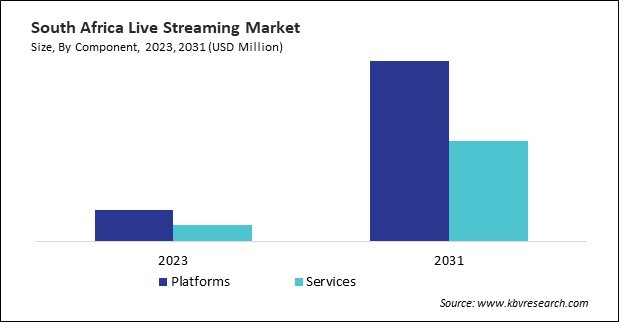The Latin America, Middle East and Africa Live Streaming Market would witness market growth of 25.3% CAGR during the forecast period (2024-2031).
The Brazil market dominated the LAMEA Live Streaming Market by Country in 2023, and would continue to be a dominant market till 2031; thereby, achieving a market value of $11,894.3 million by 2031. The Argentina market is capturing a CAGR of 26.7% during (2024 - 2031). Additionally, The UAE market would obtain a CAGR of 25% during (2024 - 2031).

The live streaming market appears to have a promising future, despite the obstacles it faces. The quality and accessibility of live streams are anticipated to be substantially improved by technological advancements, such as the deployment of 5G networks. 5G will facilitate more seamless streaming experiences, including those in high-definition formats such as 4K or 8K, due to its reduced latency and quicker speeds. Furthermore, the live streaming experience is on the brink of a revolution as a result of the integration of emerging technologies like augmented reality (AR) and virtual reality (VR), which will establish immersive environments for viewers.
The continued reliance of the gaming community on live streaming platforms has further fueled the growth of e-sports, particularly among younger demographics. Millennials and Generation Z gamers, in particular, are key drivers of this trend, spending significant time watching live streams, participating in gaming communities, and supporting their favorite streamers. With new technological advancements in streaming quality, mobile gaming, and 5G connectivity, the e-sports sector is poised to grow even more rapidly. The integration of virtual reality (VR) and augmented reality (AR) into live streaming also holds significant potential for creating more immersive gaming experiences, ensuring that live streaming will remain a central part of e-sports for years to come.
In Africa, the expansion of internet access is bolstering the live streaming market, particularly in the realm of education and professional development. According to the International Telecommunication Union (ITU), internet penetration across Africa reached 40% in 2022 and continues to grow as infrastructure improves. This increased connectivity enables more people to access live streaming platforms for educational content, professional webinars, and entertainment.
In regions where traditional educational opportunities may be limited, live streaming provides a flexible and cost-effective way to access online learning resources, enhancing social and economic mobility. The expansion of live streaming is anticipated to be significantly influenced by the continuous enhancement of internet infrastructure in Africa, particularly as a result of the increased accessibility of digital content to individuals in remote and underserved rural areas. Therefore, all these factors will aid in the growth of the market.
Free Valuable Insights: The Worldwide Live Streaming Market is Projected to reach USD 439 Billion by 2031, at a CAGR of 23.2%
Based on Component, the market is segmented into Solution and Services (Customer Information System Implementation Service, Support Service, and Legacy Extension Consulting Service). Based on Application, the market is segmented into Electricity & Power Management, Water & Wastewater Management, and Utility Gas Management. Based on countries, the market is segmented into Brazil, Argentina, UAE, Saudi Arabia, South Africa, Nigeria, and Rest of LAMEA.
By Component
By Type
By End Use
By Revenue Model
By Country
Our team of dedicated experts can provide you with attractive expansion opportunities for your business.

